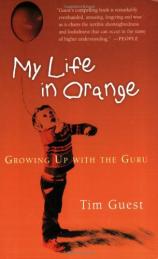Reading Group Guide
Discussion Questions
My Life in Orange: Growing Up with the Guru

1. Tim makes his feelings about Bhagwan and his organization clear, but why does he avoid saying directly that they are frauds, or exploring their motives and strategies of control? Does this restraint make the book better?
2. Why is Tim's mother attracted to the teachings of Bhagwan? How do her Catholic upbringing, her experience with psychotherapy, and her radical politics relate to her embrace of the sannyas?
3. Do any aspects of the sannyas lifestyle appeal to you? Why do you think so many educated, professional people were attracted to it?
4. Tim quotes a sannyas newspaper as asking, "Is it the stress of 20th century living that is fraying the fabric of family life? Or, is the nuclear family itself the root cause of our unbalanced, violent society?" [169] Based on Tim's experience, communal family life is clearly not preferable, but do conventional nuclear families have anything to learn from communal life? Is our culture (or our nature) fundamentally unsuited to non-nuclear family life?
5. What effect does the sexual openness of the communes have on the children? Are they more emotionally intimate and sexually experimental than children from normal families?
6. Why do you think history is not taught to children in the sannyas schools?
7. What role do toys, music, and other elements of popular, consumer culture play in Tim's life? How does his love for Legos, movies, and break dancing contrast with the insular culture of the commune? Does it help him to cope with commune life, or does it make it more difficult?
8. What is Bhagwan's attitude toward children? Why does he encourage the adults to have abortions or vasectomies?
9. What do you think of Bhagwan himself? Is he a complete charlatan? Does he believe his own teachings? Do you see any truth in them?
10. How and why does Bhagwan use the threat of nuclear war to separate the sannyasins from the rest of the world? How does his use of this kind of apocalyptic imagery compare to that of other religions or marginalized groups?
11. Another part of Bhagwan's apocalyptic rhetoric is his announcement that "AIDS will kill two thirds of the world population." [174] Why does he adopt the draconian rules limiting human contact, despite the fact that such contact has always been a cornerstone of the sannyas? Is he truly afraid of AIDS, or are the rules another means of asserting control over the lives of his followers?
12. Tim writes that in Oregon, under Sheela, "The Matriarchy operated differently from patriarchal authority. Instead of violence, they dished out 'emotional hits'; instead of prisons, there were pot-washing purgatories. They had ways to get you to do what they wanted." [210] How do the leaders get the sannyasins to do what they want at the various communes where Tim lives? How are the exercises and rules of sannyas set up to enhance individuals' loyalty to Bhagwan and the group, and to weaken all other attachments? Do you think this kind of manipulation is particularly female, as Tim implies? Why are most of the higher-ranking sannyasins women?
13. Why do the sannyasins take such a confrontational stance toward the authorities, particularly once they have moved to Oregon, by making inflammatory statements to the press, building a private armed force, etc.?
14. Discuss Tim's relationship with his father, John. Tim refers to "those summers with my father-stillness, separation, silence-everything the commune was not. . . . Each summer . . . we found we had a little less to talk about." [237] Why is John such a minor figure in the book? Fathers and sons often have difficult, distant relationships, especially when the mother and father are separated, but is this distance different? How?
15. How does the cult change over the course of Tim's life? He writes, "The Ashram had been constructed from care; the Ranch was built on guilt." [211] How and why does this shift occur?
My Life in Orange: Growing Up with the Guru
- Publication Date: February 1, 2005
- Paperback: 320 pages
- Publisher: Mariner Books
- ISBN-10: 015603106X
- ISBN-13: 9780156031066






